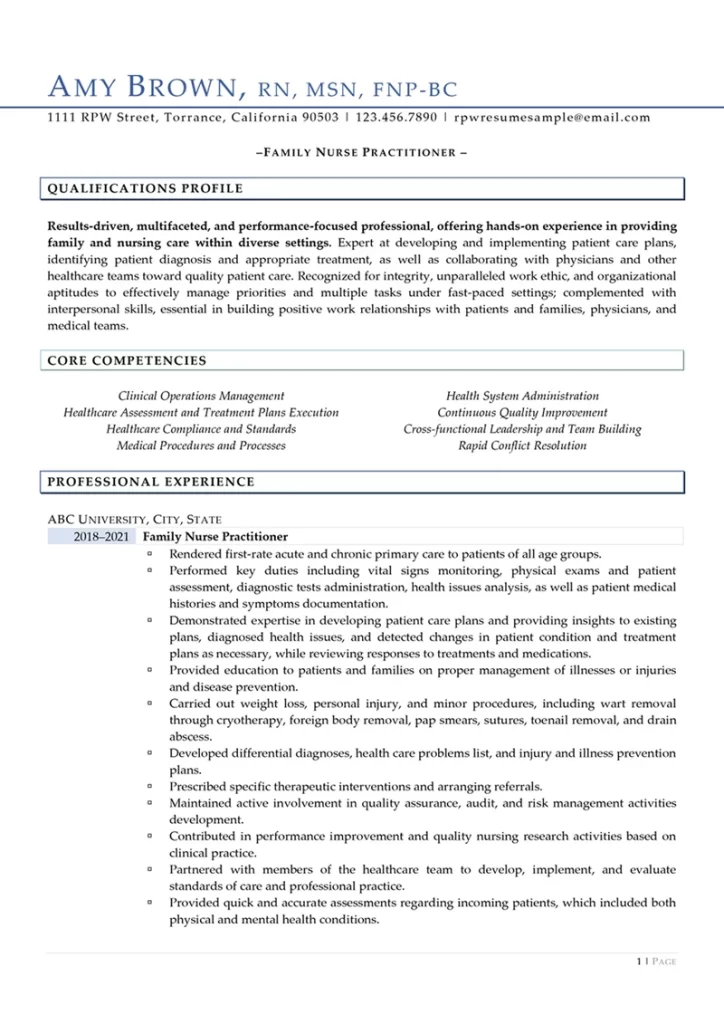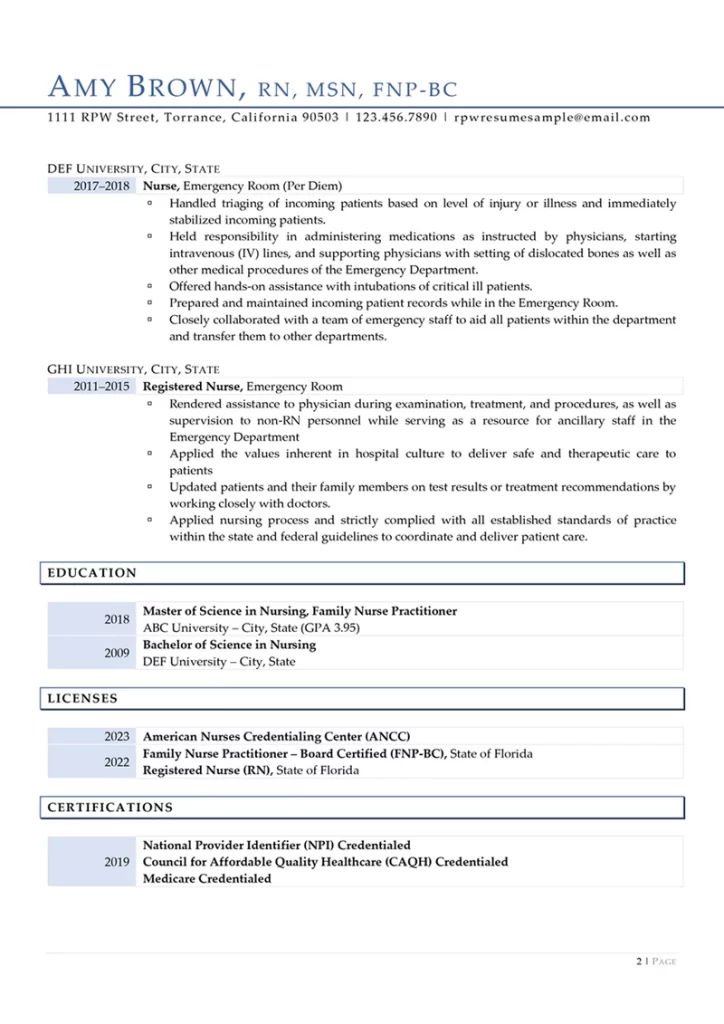As per the US Bureau of Labor Statistics or BLS, the nurse practitioner job outlook sees good growth over the years. In fact, the overall career options for such workers are expected to grow 45% from 2020 to 2030, which is faster than normal for all jobs. Furthermore, about 29,400 job posts are forecast to open each year. This is to fill the need to replace workers who shift to other jobs or retire from their posts.
That said; you must ensure your job application is impactful and lets you stand out among other job seekers. Sit tight as we present you our nurse practitioner resume guide! Learn more about this career and how you should go about your nurse practitioner resume writing. What’s more, you can ask for expert help to take care of your job search tools!
What is a Nurse Practitioner (NP)?
Nurse practitioners are healthcare experts who offer a wide range of acute, specialized, and primary care services. They coordinate patient care and work either alone or alongside a doctor. They work in various healthcare settings, such as hospitals, physician’s offices, and clinics.
It’s also worth noting that even if there are various overlaps in the roles of NPs and physicians, the former often focuses on preventing diseases as well as promoting the patients’ health and overall well-being.
What are the Duties of an NP?
As mentioned above, these healthcare workers can offer various services based on their specialty. To give you an idea of the common tasks they do, here are some of them:
- Conduct in-depth and focused physical exams
- Order and interpret tests such as x-rays, EKGs, and lab tests
- Prescribe medications and therapies
- Perform procedures
- Record patients’ medical histories and symptoms
- Monitor and operate medical equipment and tools
- Detect changes in patients’ health and edit treatment plans as needed
How Do You Become an NP?
A nurse practitioner is a registered nurse with graduate education in nursing. Often, most of them earn a master’s degree, which requires at least 2 years of full-time after the bachelor’s degree in nursing. Furthermore, they may focus on certain areas, such as:
- Pediatrics
- Family and women’s primary care
- Mental health
- Acute care
As you enter this field or continue building your career, you must acquire your license in your state and pass a national certification exam.

What to Include on Your Nurse Practitioner Resume
In writing your nurse practitioner resume, you must make sure all the key parts and details are complete. This helps you craft a strong job search tool that gives a great impression to recruiters. Nonetheless, here are the main things you should write as fitting to the job you’re vying for.
Your Contact Details
Located at the topmost part of your file, your updated contact info must include your full name in a larger font so that it’s easy to read. After or beside your name, list your credentials starting with the highest earned degree, followed by your licenses. You may also add your other disciplines and certifications.
Next, state your mailing address if you want to, under your name. Lastly, put your phone number and email address.
🔍 Think Your Resume’s Fine? Let’s Double-Check That
Even strong resumes can miss critical details—especially when it comes to passing Applicant Tracking Systems (ATS). Our specialists offer a free review to uncover gaps, improve formatting, and ensure your resume is ATS-ready and recruiter-friendly.
A Striking Intro
With recruiters spending under 10 seconds reading through resumes on average, what should you do to ensure yours won’t get tossed to the reject pile? Catch your reader’s attention through your profile.
For this part, you have various options to go for. Remember, though, that its aim is to highlight your top traits, feats, and skills. Based on your job level and goals, you may opt to choose from these 3 formats:
- Qualifications Profile
- Resume Summary
- Resume Objective
Core Skills
Just below your intro, allot a space for your top areas of expertise. The best practice is to highlight your top hard and technical skills. This also helps in showing recruiters that you have the needed skills for the role you’re aiming to land.
Key Work History
Treat this as the main course of your job search tool. This is where your readers make sense of your background as a healthcare worker.
The most basic details you need to include are your past jobs, the names of your past employers, their locations, and the inclusive years of experience you had with them. Under each item, list in bullets all the top duties you performed. Make sure the ones you state here help depict the kind of work you did before.
Your Academic Background
Since earning your state license is often a requirement, make sure to give light to your education, too. Also, being an NP means you must have a master’s degree, so you should use this space to talk about that.
Section for Your Top Skills
On the latter part of your resume, you may also opt to list your various skill sets. Opting to put a section for these not only helps enrich your job search tool with words or items you may find on the job posting; it also lets you showcase your background in your field. To guide you, here are some samples of resume skills you can list:
Soft Skills
- Listening skills
- Compassion
- Leadership
- Keen to details
- Critical thinking
- Able to think quickly
- Teamwork skills
- Social skills
Hard skills
- Treatment plans execution
- Patient care and safety
- Fall risk assessment
- IV therapy
- Chest tube management
Technical skills
- RVAD/LVAD patient care
- AICD
- Chest Tubes (Pleur-evac)
How to Write Your Nurse Practitioner Resume
With all the parts and details you must include, how should you put them together to craft a well-written resume? Heed these foolproof tips and tricks!
Resume Format
Based on your job level, you must choose the most appropriate format to follow for your resume. This way, you’ll be able to showcase your background and skills as best as you can.
For context, here are the 3 most common formats you can use:
- Reverse Chronological. From the name itself, you need to list your work history from your most recent job working your way backward. It’s best to use this type when you aim to continue the same career path or want to show steady growth in your line of work.
- Functional. This gives light to your skill sets as your major strengths. If you’re a job shifter or you have career gaps, opting for this choice helps make your work history catchier to recruiters.
- Hybrid. Stresses both your work and skills, this format combines the first 2. For that reason, this may not be the best choice for those who have yet to gain job exposure and career feats.
Job Match
As a job seeker, you must ensure your resume is tailored to the job post. You may do this by checking the job description and seeing if your background matches what the job requires.
As much as you can, don’t send a generic resume to every job. You might risk not getting your application noticed as it gives the impression you’re not putting much effort into it.
Resume Keywords
As many firms now use applicant tracking systems or ATS to screen resumes, how do you stay on top of the latest resume trends such as this? Simple: Make sure you’re using keywords that are found on the job posting, most notably the required skills and other needed traits for the role.
Layout
For normal texts, make sure to use 12 points for the size in font types that are easy to read. Further, put your larger texts such as headings and titles from 14 to 16 points in bold font. Then, use at least a single spacing to give your resume enough whitespace.
Unless stated, it’s best to save your resume as a PDF file to maintain the layout and format.
Final Check
Lastly, ensure your file is free from typos and grammar errors so that you’re only left with a polished resume. Before sending out your job search tool, read the whole thing at least twice so that you can spot what needs to be removed or edited. If it helps, you can also ask someone to do the checking for you. You can even ask for detailed feedback to further improve your work.
Sample Nurse Practitioner Resume
Now that you’re aware of the best tips and methods to write your resume, it’s now time to see what it should look like. The best way to go? Check out free nurse practitioner resume examples! In fact, here’s one sample we’ve prepared for you.


Have Your New Nurse Practitioner Resume Written by an Expert
While some job seekers try to write their own job search tools, finding the right balance between juggling their job search efforts may be jarring.
Browse through our best resume writing services and see how our team can help you get hired faster and land your dream job! If you don’t want to start writing from scratch, why not have your tool checked by an expert? We also offer a free resume review so that you’ll get feedback from one of our career coaches! Just follow our easy steps or talk to us to get started.








